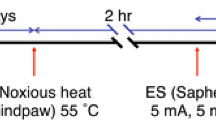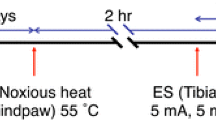Abstract
Previous studies demonstrated that peripheral nerve injury induced excessive neuronal response and glial activation in the spinal cord dorsal horn, and such change has been proposed to reflect the development and maintenance of neuropathic pain states. The aim of this study was to examine neuronal excitability and glial activation in the spinal dorsal horn after peripheral nerve injury. We examined noxious heat stimulation-induced c-Fos protein-like immunoreactivity (Fos-LI) neuron profiles in fourth-to-sixth lumbar (L4–L6) level spinal dorsal horn neurons after fifth lumbar spinal nerve ligation (L5 SNL). Immunofluorescence labeling of OX-42 and GFAP was also performed in histological sections of the spinal cord. A significant increase in the number of Fos-LI neuron profiles in the spinal dorsal horn at the L4 level was found at 3 days after SNL, but returned to a level similar to that in sham-operated controls by 14 days after injury. As expected, a decrease in the number of Fos-LI neuron profiles in the spinal dorsal horn at the L5 level was found at 3 days after SNL. However, these profiles had reappeared in large numbers by 14 and 21 days after injury. Immunofluorescence labeling of OX-42 and GFAP indicated sequential activation of microglia and astrocytes in the spinal dorsal horn. We conclude that nerve injury causes differential changes in neuronal excitability in the spinal dorsal horn, which may coincide with glial activation. These changes may play a substantial role in the pathogenesis of neuropathic pain after peripheral nerve injury.






Similar content being viewed by others
Abbreviations
- ANOVA:
-
Analysis of variance
- DAB:
-
Diaminobenzidine
- ERK:
-
Extracellular signal-regulated kinase
- Fos-LI:
-
c-Fos protein-like immunoreactive
- GFAP:
-
Glial fibrillary acidic protein
- i.p.:
-
Intraperitoneal
- PAP:
-
Peroxidase anti-peroxidase
- PB:
-
Phosphate buffer
- PBS:
-
Phosphate-buffered saline
- p-ERK:
-
Phosphorylated ERK
- SNL:
-
Spinal nerve ligation
References
Zimmermann M (2001) Pathobiology of neuropathic pain. Eur J Pharmacol 429 (1–3):23–37
Devor M, Wall PD (1978) Reorganisation of spinal cord sensory map after peripheral nerve injury. Nature 276(5683):75–76
Hylden JL, Nahin RL, Dubner R (1987) Altered responses of nociceptive cat lamina I spinal dorsal horn neurons after chronic sciatic neuroma formation. Brain Res 411(2):341–350
Lisney SJ (1983) Changes in the somatotopic organization of the cat lumbar spinal cord following peripheral nerve transection and regeneration. Brain Res 259(1):31–39
Markus H, Pomeranz B, Krushelnycky D (1984) Spread of saphenous somatotopic projection map in spinal cord and hypersensitivity of the foot after chronic sciatic denervation in adult rat. Brain Res 296(1):27–39
Sugimoto T, Ichikawa H, Hijiya H, Mitani S, Nakago T (1993) c-Fos expression by dorsal horn neurons chronically deafferented by peripheral nerve section in response to spared, somatotopically inappropriate nociceptive primary input. Brain Res 621(1):161–166
Nomura H, Ogawa A, Tashiro A, Morimoto T, Hu JW, Iwata K (2002) Induction of Fos protein-like immunoreactivity in the trigeminal spinal nucleus caudalis and upper cervical cord following noxious and non-noxious mechanical stimulation of the whisker pad of the rat with an inferior alveolar nerve transection. Pain 95(3):225–238
Fujisawa N, Terayama R, Yamaguchi D, Omura S, Yamashiro T, Sugimoto T (2012) Fos protein-like immunoreactive neurons induced by electrical stimulation in the trigeminal sensory nuclear complex of rats with chronically injured peripheral nerve. Exp Brain Res 219(2):191–201. doi:10.1007/s00221-012-3078-8
Terayama R, Kishimoto N, Yamamoto Y, Maruhama K, Tsuchiya H, Mizutani M, Iida S, Sugimoto T (2015) Convergent nociceptive input to spinal dorsal horn neurons after peripheral nerve injury. Neurochem Res 40(3):438–445. doi:10.1007/s11064-014-1484-y
Terayama R, Yamamoto Y, Kishimoto N, Maruhama K, Mizutani M, Iida S, Sugimoto T (2015) Peripheral nerve injury activates convergent nociceptive input to dorsal horn neurons from neighboring intact nerve. Exp Brain Res 233(4):1201–1212. doi:10.1007/s00221-015-4203-2
Kim SH, Chung JM (1992) An experimental model for peripheral neuropathy produced by segmental spinal nerve ligation in the rat. Pain 50(3):355–363
Bian D, Ossipov MH, Zhong C, Malan TP Jr, Porreca F (1998) Tactile allodynia, but not thermal hyperalgesia, of the hindlimbs is blocked by spinal transection in rats with nerve injury. Neurosci Lett 241(2–3):79–82
Raghavendra V, Tanga F, DeLeo JA (2003) Inhibition of microglial activation attenuates the development but not existing hypersensitivity in a rat model of neuropathy. J Pharmacol Exp Ther 306(2):624–630. doi:10.1124/jpet.103.052407
Terayama R, Omura S, Fujisawa N, Yamaai T, Ichikawa H, Sugimoto T (2008) Activation of microglia and p38 mitogen-activated protein kinase in the dorsal column nucleus contributes to tactile allodynia following peripheral nerve injury. Neuroscience 153 (4):1245–1255. doi:10.1016/j.neuroscience.2008.03.041
Shehab SA, Al-Marashda K, Al-Zahmi A, Abdul-Kareem A, Al-Sultan MA (2008) Unmyelinated primary afferents from adjacent spinal nerves intermingle in the spinal dorsal horn: a possible mechanism contributing to neuropathic pain. Brain Res 1208:111–119. doi:10.1016/j.brainres.2008.02.089
Hains BC, Waxman SG (2006) Activated microglia contribute to the maintenance of chronic pain after spinal cord injury. J Neurosci 26(16):4308–4317
Tsuda M, Inoue K, Salter MW (2005) Neuropathic pain and spinal microglia: a big problem from molecules in “small” glia. Trends Neurosci 28 (2):101–107. doi:10.1016/j.tins.2004.12.002
Tsuda M, Mizokoshi A, Shigemoto-Mogami Y, Koizumi S, Inoue K (2004) Activation of p38 mitogen-activated protein kinase in spinal hyperactive microglia contributes to pain hypersensitivity following peripheral nerve injury. Glia 45(1):89–95. doi:10.1002/glia.10308
Watkins LR, Milligan ED, Maier SF (2001) Glial activation: a driving force for pathological pain. Trends Neurosci 24 (8):450–455
Watkins LR, Milligan ED, Maier SF (2001) Spinal cord glia: new players in pain. Pain 93 (3):201–205
Garrison CJ, Dougherty PM, Kajander KC, Carlton SM (1991) Staining of glial fibrillary acidic protein (GFAP) in lumbar spinal cord increases following a sciatic nerve constriction injury. Brain Res 565 (1):1–7
Kalla R, Liu Z, Xu S, Koppius A, Imai Y, Kloss CU, Kohsaka S, Gschwendtner A, Moller JC, Werner A, Raivich G (2001) Microglia and the early phase of immune surveillance in the axotomized facial motor nucleus: impaired microglial activation and lymphocyte recruitment but no effect on neuronal survival or axonal regeneration in macrophage-colony stimulating factor-deficient mice. J Comp Neurol 436(2):182–201
DeLeo JA, Yezierski RP (2001) The role of neuroinflammation and neuroimmune activation in persistent pain. Pain 90 (1–2):1–6
Hanisch UK (2002) Microglia as a source and target of cytokines. Glia 40(2):140–155. doi:10.1002/glia.10161
Swett JE, Woolf CJ (1985) The somatotopic organization of primary afferent terminals in the superficial laminae of the dorsal horn of the rat spinal cord. J Comp Neurol 231(1):66–77. doi:10.1002/cne.902310106
Bullitt E (1990) Expression of c-fos-like protein as a marker for neuronal activity following noxious stimulation in the rat. J Comp Neurol 296(4):517–530
Hunt SP, Pini A, Evan G (1987) Induction of c-fos-like protein in spinal cord neurons following sensory stimulation. Nature 328(6131):632–634
Strassman AM, Vos BP (1993) Somatotopic and laminar organization of fos-like immunoreactivity in the medullary and upper cervical dorsal horn induced by noxious facial stimulation in the rat. J Comp Neurol 331(4):495–516
Strassman AM, Vos BP, Mineta Y, Naderi S, Borsook D, Burstein R (1993) Fos-like immunoreactivity in the superficial medullary dorsal horn induced by noxious and innocuous thermal stimulation of facial skin in the rat. J Neurophysiol 70(5):1811–1821
Sugimoto T, Hara T, Shirai H, Abe T, Ichikawa H, Sato T (1994) c-fos induction in the subnucleus caudalis following noxious mechanical stimulation of the oral mucous membrane. Exp Neurol 129(2):251–256
Williams S, Evan GI, Hunt SP (1990) Changing patterns of c-fos induction in spinal neurons following thermal cutaneous stimulation in the rat. Neuroscience 36(1):73–81
Bennett GJ, Abdelmoumene M, Hayashi H, Dubner R (1980) Physiology and morphology of substantia gelatinosa neurons intracellularly stained with horseradish peroxidase. J Comp Neurol 194(4):809–827. doi:10.1002/cne.901940407
Shehab SA (2014) Fifth lumbar spinal nerve injury causes neurochemical changes in corresponding as well as adjacent spinal segments: a possible mechanism underlying neuropathic pain. J Chem Neuroanat 55:38–50. doi:10.1016/j.jchemneu.2013.12.002
Shehab S, Anwer M, Galani D, Abdulkarim A, Al-Nuaimi K, Al-Baloushi A, Tariq S, Nagelkerke N, Ljubisavljevic M (2015) Anatomical evidence that the uninjured adjacent L4 nerve plays a significant role in the development of peripheral neuropathic pain after L5 spinal nerve ligation in rats. J Comp Neurol 523(12):1731–1747. doi:10.1002/cne.23750
Woolf CJ, Wall PD (1982) Chronic peripheral nerve section diminishes the primary afferent A-fibre mediated inhibition of rat dorsal horn neurones. Brain Res 242(1):77–85
Shim B, Ringkamp M, Lambrinos GL, Hartke TV, Griffin JW, Meyer RA (2007) Activity-dependent slowing of conduction velocity in uninjured L4 C fibers increases after an L5 spinal nerve injury in the rat. Pain 128(1–2):40–51. doi:10.1016/j.pain.2006.08.023
Wu G, Ringkamp M, Hartke TV, Murinson BB, Campbell JN, Griffin JW, Meyer RA (2001) Early onset of spontaneous activity in uninjured C-fiber nociceptors after injury to neighboring nerve fibers. J Neurosci 21(8):Rc140
Wu G, Ringkamp M, Murinson BB, Pogatzki EM, Hartke TV, Weerahandi HM, Campbell JN, Griffin JW, Meyer RA (2002) Degeneration of myelinated efferent fibers induces spontaneous activity in uninjured C-fiber afferents. J Neurosci 22(17):7746–7753
Clark AK, Gentry C, Bradbury EJ, McMahon SB, Malcangio M (2007) Role of spinal microglia in rat models of peripheral nerve injury and inflammation. Eur J Pain 11(2):223–230. doi:10.1016/j.ejpain.2006.02.003
Coyle DE (1998) Partial peripheral nerve injury leads to activation of astroglia and microglia which parallels the development of allodynic behavior. Glia 23(1):75–83
Tawfik VL, Nutile-McMenemy N, Lacroix-Fralish ML, Deleo JA (2007) Efficacy of propentofylline, a glial modulating agent, on existing mechanical allodynia following peripheral nerve injury. Brain Behav Immun 21(2):238–246. doi:10.1016/j.bbi.2006.07.001
Watkins LR, Maier SF (2003) Glia: a novel drug discovery target for clinical pain. Nat Rev Drug Discov 2(12):973–985. doi:10.1038/nrd1251
Eriksson NP, Persson JK, Aldskogius H, Svensson M (1997) A quantitative analysis of the glial cell reaction in primary sensory termination areas following sciatic nerve injury and treatment with nerve growth factor in the adult rat. Exp Brain Res 114(3):393–404
Kreutzberg GW (1996) Microglia: a sensor for pathological events in the CNS. Trends Neurosci 19 (8):312–318
Yamamoto Y, Terayama R, Kishimoto N, Maruhama K, Mizutani M, Iida S, Sugimoto T (2015) Activated microglia contribute to convergent nociceptive inputs to spinal dorsal horn neurons and the development of neuropathic pain. Neurochem Res. doi:10.1007/s11064-015-1555-8
Colburn RW, DeLeo JA, Rickman AJ, Yeager MP, Kwon P, Hickey WF (1997) Dissociation of microglial activation and neuropathic pain behaviors following peripheral nerve injury in the rat. J Neuroimmunol 79 (2):163–175
Colburn RW, Rickman AJ, DeLeo JA (1999) The effect of site and type of nerve injury on spinal glial activation and neuropathic pain behavior. Exp Neurol 157 (2):289–304. doi:10.1006/exnr.1999.7065
Acknowledgments
This study was supported by a Grant-in-Aid for Scientific Research from the Japan Society for the Promotion of Science (16K11440).
Author information
Authors and Affiliations
Corresponding author
Ethics declarations
Conflict of Interest
The authors do not have any conflict of interest.
Rights and permissions
About this article
Cite this article
Terayama, R., Yamamoto, Y., Kishimoto, N. et al. Differential Changes in Neuronal Excitability in the Spinal Dorsal Horn After Spinal Nerve Ligation in Rats. Neurochem Res 41, 2880–2889 (2016). https://doi.org/10.1007/s11064-016-2003-0
Received:
Revised:
Accepted:
Published:
Issue Date:
DOI: https://doi.org/10.1007/s11064-016-2003-0




